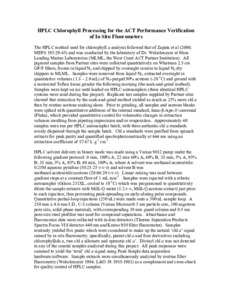| dc.date.accessioned | 2019-01-24T16:42:39Z | |
| dc.date.available | 2019-01-24T16:42:39Z | |
| dc.date.issued | 2004 | |
| dc.identifier.citation | Alliance for Coastal Technology (2004) HPLC Chlorophyll Processing for the ACT Performance Verification of In Situ Fluorometers. Solomons, MD, Alliance for Coastal Technologies, 1pp. DOI: http://dx.doi.org/10.25607/OBP-360 | en_US |
| dc.identifier.uri | http://hdl.handle.net/11329/804 | |
| dc.identifier.uri | http://dx.doi.org/10.25607/OBP-360 | |
| dc.description.abstract | The HPLC method used for chlorophyll a analysis followed that of Zapata et al (2000;
MEPS 195:29-45) and was conducted by the laboratory of Dr. Welschmeyer at Moss
Landing Marine Laboratories (MLML, the West Coast ACT Partner Institution). All
pigment samples from Partner sites were collected quantitatively on Whatman 2.5 cm
GF/F filters, frozen in liquid N2 and shipped by overnight courier in liquid N2 dry
shippers to MLML. Samples were removed from liquid N2, extracted overnight in
quantitative volumes (1.8 – 2.0 mL) of N2-purged 90% acetone (-20 oC) and ground with
a motorized Teflon tissue grinder the following morning (the soak-and-grind method).
Samples were kept on ice until loaded on HPLC autosamplers (three identical HPLC
systems were used during this project). Replicate test samples supplied by Partner sites
showed that extraction by the soak-and-grind method yielded as much as 25% more chl a
than by routine acetone soaking alone. Prior to grinding, all samples and acetone blanks
were spiked with quantitative additions of the internal standard, trans-β-Apo-8′-carotenal
(Fluka), which provided quantitative control for volumetric changes in extraction
volumes resulting from pipeting imprecision and/or evaporation. Approximately 40
samples were run per HPLC autosampler batch, with three authentic chl a standards
evenly dispersed through the sample batch. Chl a standards were purified from spinach
extracts for peak purity and quantified spectrophotometrically at 664 nm using an
extinction coefficient of 87.67 L g-1 cm-1.
HPLC solvent delivery in binary mode was made using a Varian 9012 pump under the
following gradient protocol: 0 min, 100% A; 22 min 60% A, 40% B; 28 min, 5% A, 95%
B; 38 min, 5% A, 95% B; 40 min, 100% A; where A solvent was methanol:acetonitrile:
0.25M aqueous pyridine (50:25:25 v:v:v) and solvent B was
methanol:acetonitrile:acetone (20:60:20 v:v:v). Linear mixing was used between
gradient steps at a constant flow of 1 mL min-1. Samples were injected with a robotic
autosampler (Gilson 231XL, cooled to 10 oC) which was programmed to quantitatively
dilute the sample extracts with Milli-Q water (1:2 v:v, Milli-Q:acetone extract) just prior
to each injection, thus preventing peak-spreading on early-eluting polar compounds.
Quantitative partial-loop injections (250 uL) were made onto a 500 uL sample loop. A
250 mm x 4.6 mm I.D., C-8 column (Varian Microsorb 5 um particle size, 100 angstrom
pore size, solid-phase material), with corresponding 30 mm guard column and 0.5 um
pore-size steel prefilter was used for compound separations. Absorbance and
fluorescence data were collected with in-line detectors (Thermo Separation Products
Spectra Focus VIS detector 440 nm and Kratos 950 filter fluorometer). Samples
routinely yielded five peaks which were considered to make up the natural ‘chl a’ signal
sensed by in situ fluorometry; specifically, parent chl a and four derivatives including
chlorophyllide a, two chl a allomers and epimeric chl a’. Divinyl chl a was not detected
in any of the coastal samples analyzed during this project. All peak responses were
summed to yield the ‘total’ chl a signal using Peak Simple data acquisition
hardware/software. Sample extracts were simultaneously analyzed by routine filter
fluorometry (Welschmeyer 1994; L&O 39:1985-1992) as a complement and cross-check
for quality control of HPLC samples. | en_US |
| dc.language.iso | en | en_US |
| dc.publisher | Alliance for Coastal Technologies (ACT) | en_US |
| dc.rights | CC0 1.0 Universal | * |
| dc.rights.uri | http://creativecommons.org/publicdomain/zero/1.0/ | * |
| dc.title | HPLC Chlorophyll Processing for the ACT Performance Verification of In Situ Fluorometers. | en_US |
| dc.type | Report | en_US |
| dc.description.status | Published | en_US |
| dc.format.pages | 1pp. | en_US |
| dc.contributor.corpauthor | Alliance for Coastal Technologies | |
| dc.description.refereed | Refereed | en_US |
| dc.publisher.place | Solomons, MD | en_US |
| dc.subject.parameterDiscipline | Biogeochemistry | en_US |
| dc.subject.instrumentType | Fluorometers | |
| dc.description.currentstatus | Current | en_US |
| dc.description.eov | Ocean colour | en_US |
| dc.description.bptype | Best Practice | en_US |
| dc.description.bptype | Standard Operating Procedure | en_US |
| obps.contact.contactemail | info@act-us.info | |
| obps.resourceurl.publisher | http://www.act-us.info/evaluations.php | en_US |
 Repository of community practices in Ocean Research, Applications and Data/Information Management
Repository of community practices in Ocean Research, Applications and Data/Information Management

